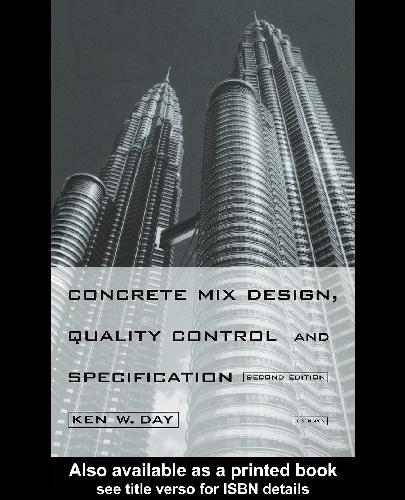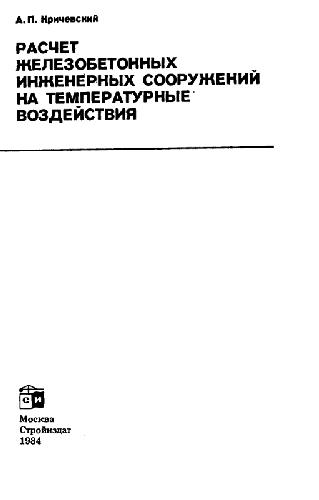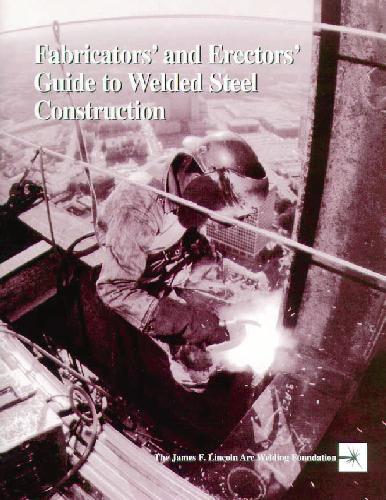Ken W Day,NetLibrary, Inc.0203220730, 9780203220733
Table of contents :
Book Cover……Page 1
Half-Title……Page 2
Title……Page 3
Copyright……Page 4
Contents……Page 5
Preface to second edition……Page 10
Preface to first edition……Page 12
Acknowledgements……Page 15
Foreword……Page 16
1.1 PHILOSOPHY……Page 21
1.3 USE OF STRENGTH AS A BASIS……Page 22
Chemical attack……Page 23
1.4.2 Permeability……Page 24
1.4.3 Pumpability……Page 26
1.4.5 Heat generation……Page 28
1.5.1 Variability……Page 30
1.5.3 Early age strength……Page 31
1.6 THE CUBE/CYLINDER RELATIONSHIP……Page 32
1.7 FLEXURAL AND TENSILE STRENGTH……Page 33
2.1 1:2:4 MIXES……Page 37
2.3 GAP GRADINGS……Page 38
2.4 ROAD NOTE 4……Page 39
2.5 BRE/DOE SYSTEM……Page 40
2.6.1 Basis of manual use……Page 43
Sand specific surface……Page 45
2.7 THE ACI SYSTEM……Page 46
2.8 TRIAL MIX METHODS……Page 47
2.9 DEWAR: PARTICLE INTERFERENCE AND VOID FILLING……Page 49
2.11 POPOVICS……Page 52
2.12 BRUSIN METHOD……Page 53
2.13 RILEM TECHNICAL COMMITTEE TC 70-OMD……Page 54
2.14 ASSESSMENT OF ALTERNATIVES……Page 55
3.1 VALIDATION OF THE METHOD……Page 57
3.2 PROVIDING SERVICE TO AN EXISTING MAJOR PRODUCER……Page 59
3.3 THE CONAD CONCEPT: MSF, EWF AND SS……Page 60
3.4 SPECIFIC SURFACE……Page 61
3.6 PARTICLE SHAPE……Page 62
3.7 MODIFIED SPECIFIC SURFACE……Page 63
3.8 SILT CONTENT……Page 64
3.9 PACKING CONSIDERATIONS……Page 65
3.11 WATER FACTOR (INCLUDING WATER-REDUCING ADMIXTURE EFFECT)……Page 66
3.11.3 Coarse aggregates……Page 68
3.13 OVERALL WATER PREDICTIONS……Page 70
3.14 FINE AGGREGATE WATER REQUIREMENT RELATED TO VOID PERCENTAGE AND FLOW TIME……Page 71
3.15 STRENGTH CONSIDERATIONS……Page 73
3.16 YIELD AND UNIT WEIGHT……Page 75
3.17 TRIAL MIXES……Page 76
3.18 IMPLEMENTATION SYSTEMS……Page 77
3.18.1 The basic system……Page 78
3.18.2 The Automix system……Page 80
3.18.3 The Mixtable system……Page 83
3.18.4 Cement Margins program……Page 84
3.18.5 The Benchmark system……Page 86
3.18.6 The Trial Mix program……Page 88
QC Demo……Page 90
Mix Demo……Page 92
3.20 HIGH STRENGTH/HIGH PERFORMANCE CONCRETE……Page 95
4 Philosophy and techniques of quality control……Page 99
4.1.1 Changing attitudes……Page 100
4.1.2 The objectives of quality control and quality assurance……Page 101
4.2.1 The distribution pattern……Page 102
4.2.2 Factors causing variability……Page 103
4.2.3 The significance of control action requirements……Page 105
4.3.1 Who should control?……Page 106
4.3.2 Quality assurance……Page 107
4.3.3 Pareto’s principle……Page 108
Monitoring day to day performance variations……Page 109
4.4.1 General……Page 110
4.4.2 Shewhart charts……Page 111
4.4.3 Cusum charts……Page 112
Different roles for cusum analysis……Page 115
4.4.4 Factors affecting rapidity of control action……Page 116
4.5.1 Change point detection……Page 117
4.5.2 Development of computerization……Page 118
4.5.3 Recent developments……Page 119
5.1 DEVELOPMENT OF THE SYSTEM……Page 122
5.3 COMPREHENSIVE INTEGRATION……Page 123
5.4 DATA STORAGE AND RETRIEVAL……Page 124
5.5 COMPUTER BATCHING ANALYSIS……Page 127
5.6 FIELD AND LABORATORY TEST DATA INPUT……Page 130
5.7 DATA RETRIEVAL AND ANALYSIS……Page 133
5.8 MULTIGRADE, MULTIVARIABLE ANALYSIS……Page 135
5.9 SINGLE GRADE ANALYSIS……Page 142
5.10 MATERIAL PROPERTIES……Page 144
5.12 STATISTICAL TABLE……Page 145
5.13 INTEGRATION OF BATCHING DATA WITH CONCRETE TEST DATA……Page 148
5.14 EVALUATION OF RELATIVE EFFICIENCY OF MIXES……Page 151
5.16 PREDICTION OF 28-DAY STRENGTH……Page 153
5.17 NUMBER OF SPECIMENS PER SAMPLE……Page 156
5.18 DEPRESSION OF MEAN STRENGTH BY TESTING ERROR……Page 157
5.19 A SELF-REGULATING BATCH PLANT?……Page 158
6.1 DEFICIENCIES OF EXISTING SPECIFICATION TECHNIQUES……Page 160
6.2.1 Aspects of quality……Page 161
6.2.2 Possible deleterious effects of specifications……Page 164
6.2.3 Encouragement of good control……Page 165
6.2.5 The solution of separating requirements……Page 166
6.3 CASH PENALTY SPECIFICATIONS……Page 167
6.4 RAPID REACTION TO UNSATISFACTORY QUALITY……Page 168
6.5.2 Batch plant equipment……Page 169
6.7 PROPOSAL-APPROVAL SPECIFICATIONS……Page 170
6.7.1 Early detection of changes……Page 171
6.8 THE RECOMMENDED SPECIFICATION……Page 172
6.8.1 Development of standard mixes……Page 173
6.8.3 Shrinkage……Page 174
6.8.4 Durability……Page 175
6.8.6 Bleeding……Page 176
6.8.10 Heat generation……Page 177
6.9 SMALL VOLUME PROJECTS OR PLANTS……Page 178
6.10 SUMMARY……Page 185
7.1 FINE AGGREGATE (SAND)……Page 187
7.1.1 Grading……Page 188
7.1.3 Grading indices……Page 190
7.1.4 Air entrainment……Page 194
7.1.5 Particle shape……Page 195
7.1.6 Clay, silt or dust content……Page 196
Chemical impurities……Page 197
7.1.8 Example of implementation of specific surface concept……Page 198
7.1.9 Summary……Page 199
7.2 COARSE AGGREGATE……Page 200
7.3 LIGHTWEIGHT AGGREGATES……Page 202
7.4 BLAST FURNACE SLAG……Page 204
8.1.2 What can go wrong with cement?……Page 205
8.1.3 Significant test results……Page 206
8.1.4 Types of cement……Page 208
8.2.1 General characteristics……Page 209
8.2.2 The composition of fly ash……Page 210
Chemical effects……Page 211
8.2.5 Advantages of fly ash……Page 212
8.3.1 Properties of granulated, ground, blast furnace slag……Page 213
8.3.3 Heat generation……Page 214
8.4 SILICA FUME……Page 215
8.4.3 Cohesion and resistance to bleeding……Page 216
8.5 RICE HULL ASH……Page 217
8.7 COLLOIDAL SILICA……Page 218
9.1 GENERAL……Page 219
9.3 POSSIBLE REASONS FOR USING ADMIXTURE……Page 220
9.4.3 Retarders……Page 221
9.4.4 Accelerators……Page 222
9.4.6 ‘Waterproofers’ (or, more realistically, permeability reducers)……Page 223
9.4.7 Pumping aids……Page 224
9.4.8 Superplasticizers……Page 225
9.4.9 Shrinkage compensators……Page 226
10 Statistical analysis……Page 228
10.1 THE NORMAL DISTRIBUTION……Page 229
10.2 PERMISSIBLE PERCENTAGE DEFECTIVE……Page 230
10.4 VARIABILITY OF STANDARD DEVIATION ASSESSMENT……Page 234
10.5 COMPONENTS OF VARIABILITY……Page 235
10.6 TESTING ERROR……Page 236
10.7 COEFFICIENT OF VARIATION……Page 237
10.8 PRACTICAL SIGNIFICANCE……Page 238
11.1 RANGE OF TESTS……Page 240
11.3 COMPRESSION TESTING……Page 242
11.5 TESTING MACHINE TECHNOLOGY……Page 243
11.6 BAD CONCRETE OR BAD TESTING?……Page 244
11.7 ROUNDING RESULTS……Page 246
11.8 CUBES VERSUS CYLINDERS……Page 247
11.9 NON-DESTRUCTIVE TESTING……Page 250
11.10.1 Workability……Page 251
11.10.3 Air content……Page 252
11.10.4 Density……Page 253
11.10.7 Wet analysis……Page 254
11.10.8 Conclusion……Page 255
12.1.1 New rheometers……Page 256
12.1.2 Truck mounted workability control……Page 257
12.1.3 Slump……Page 263
12.1.6 Two-point test……Page 265
Slump as a criterion……Page 267
Fines content……Page 268
12.1.7 Significance and use of Tattersall’s concepts……Page 269
12.2 MATURITY/EQUIVALENT AGE……Page 270
12.2.1 Prediction of standard 28-day and current in situ strengths……Page 272
12.2.2 Limitations of the equivalent age concept……Page 273
12.2.4 Temperature cycles and stresses……Page 274
12.3 CASH PENALTY SPECIFICATION……Page 275
12.3.2 Accuracy of assessment……Page 276
12.3.4 Effect of k value changes……Page 277
12.3.5 The influence of change points……Page 280
12.3.7 Legal enforceability……Page 281
12.4 WHAT IS ECONOMICAL CONCRETE?……Page 282
12.5 INDUSTRIAL FLOOR SURFACES……Page 284
12.5.2 Wear resistance……Page 285
12.5.3 Bleeding……Page 286
12.5.6 Surface working……Page 287
12.5.7 Power trowelling……Page 288
12.5.10 Dry shakes……Page 289
12.5.11 Curing……Page 290
12.6.1 The problem investigated……Page 291
First-stage program……Page 293
12.6.3 Tuning of systems……Page 294
12.6.4 Relative performance of the systems……Page 295
System details……Page 296
12.6.6 Assessment of alternatives……Page 297
12.6.7 Other significant considerations……Page 298
13 Troubleshooting……Page 300
13.1 INADEQUATE STRENGTH……Page 301
13.2 POOR WORKABILITY/PUMPABILITY……Page 302
13.3.3 Evaporation cracks……Page 303
13.4 CAUSES OF CRACKING IN CONCRETE SLABS……Page 304
Summary and Conclusions……Page 306
References……Page 308
Concrete Advice Pty LtdConcrete Advice is a small but internationally well known Australian company. It was founded in 1973 by Ken Day.Our main product is the CONAD integrated concrete mix design and quality control computer program. Our principal, Ken Day, began the developments leading to the system in 1952 when he originated his own form of specific surface mix design and first started multi-variable control graphing.The original business of Concrete Advice was as a general consultant and trou……Page 312
About the CD-ROM……Page 313
Index……Page 317







Reviews
There are no reviews yet.